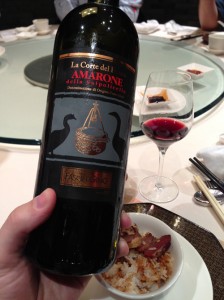Wine at Night, Tea During the Day
Although I never had intentions of turning this into a broad beverage blog, (see: domain name) recently I have spent a lot of time researching and drinking wine. Wine and tea actually compliment each other quite well. For the caffeine sensitive, drinking raw puer tea at 8 PM mean a sleepless night. For those who must adhere to social norms, having a bottle of wine at 9 am is farther from charming and more towards alcoholism. Better to balance it out and have tea with the sun and wine with the moon.
My wine drinking in the past 3 months has been mostly scattered around European wines with some new world wines, but one wine in particular has repeatedly come up, Amarone della Valpolicella, a wine from Veneto, Italy. Not by grand design, but due to several chance meetings, expos, and wine tastings, I have had about 25 different Amarones in the last month. After snapping some pictures along the way and getting an Amarone crash course I have arrived at this post.
First, a quick description of Amarone, which the bubbly professor explains much better than I ever could, so here is her lovely explanation:
Amarone della Valpolicella: Amarone della Valpolicella received its DOCG in 2009. Amarone is a well-known version of Valpolicella made using the partially dried grape process known as apassimento. The grapes used for Amarone must be dried until December 1st following the harvest. The wine must also be aged for two years from the 1st of January following the vintage. (Riserva versions must be aged 4 years from November 1st of the vintage year.) The minimum alcohol percentage of Amarone della Valpolicella is 14%. While technically considered a dry wine, small amounts of residual sugar are allowed; the amount allowed is in proportion to the amount of alcohol with higher alcohol wines allowed slightly larger amounts of R.S. Interesting factoid: Along with the 2009 DOCG decree, Molinara is no longer a required component of Amarone della Valpolicella, although it may be used in small amounts for blending.
Key points to hit the DOCG [Italian wine grade meaning denominazione di origine controllata]: made from partially dried grapes, which means more sugar/more alcohol. Aged at least two years, four for Riserva. The grapes involved are majority Corvina, less Rodinella, and sometimes Molinara. It is generally full bodied and fruity.

Aging Amarones
I was lucky enough to end up at a wine event where they had Amarones ranging from 1990, 1995, 1997, and the early 2000’s. Having these wines side-by-side gave me a glimpse into how the character of an Amarone evolves over time. Similar to puer tea, the sharper rough components of a wine get smoothed out by the grindstone of time. The analogy of a sharp young puer tea rounding out into a more silky orb-like flavor seems to fit. Another of my amateur observations was that they seemed to have a sweet spot around 15-18 years. The 1990 vintage seemed to have surpassed what I desired out of the wine. Anytime you give up something for smoothness, you lose something in character. This also happens with puer, certain very old teas drift into nowhere in certain storage conditions and after a certain period of time. After all the changes have to occur within a finite amount of material. All of the aged Amarones from 1990 were from Masi, a large wine producer who produces 3.5 million bottles per year. The featured image at the top is a row of Masi Amarones.

A+ Amarone
After a barrage of different wines, only a select few producers and wines really stood out in my mind. Most of my favorites were from smaller producers – in comparison to Masi – such as Fasoli Gino, who makes some of my favorites from the group. (Their Soave called Pievi Vecchia is also damn great) Fasoli Gino is an organic producer in Veneto with really innovative wines. The Alteo is their best Amarone, and my favorite Amarone of the bunch. For a wine with 17.5% alcohol content, it is very balanced. Lot of dark fruit, cocoa, and some wood tastes which I thought were close to cedar or sandalwood. The wine transformed from glass to glass, which as with tea, is the it. If I can steep a tea for a session and have it go on a journey, that’s it. Sign me up. Ditto for wine. If I can drink a bottle of wine and have the wine lead me down a path, I am in. It’s not an easy mark to hit, but the Alteo did it for me. Their other Amarones were also excellent – the bottom of the Fasoli range was still better than most of the Masi offerings; another correlation between tea and wine, bigger productions just can’t compete on quality.

The one Masi wine that did stick in my mind was the Riserva di Costasera Amarone Clasico 2007. Let’s call it a Jin Dayi and move on.

The other Amarone I really enjoyed was the Villa Canestrari 1888 Riserva 2006. Another wine that had a lot of guts, with some flavors that reminded me of dark syrupy tobacco. Their Plenum was also good with a lot less going on in terms of complexity, but better value.
And so concludes my first article in wine territory. Hopefully I didn’t step on any sommelier toes. If you happen to be a wine freak, feel free to correct me in the comments, although I suspect you stopped reading after my 5th puer reference.

